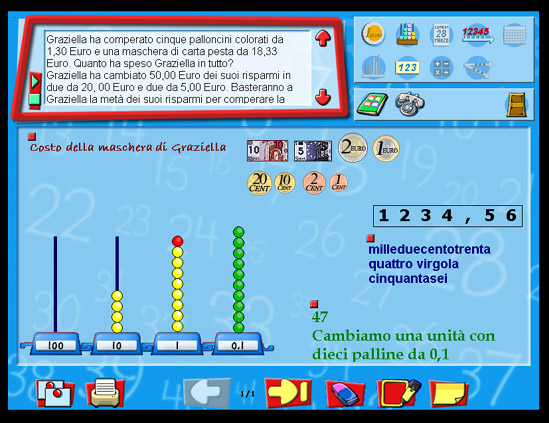Difficulties in math learning are frequently reported. Often the ability of understanding or not understanding math is a key factor in school success.
At ITD innovative ICT- based learning environments are being studied. They aim at improving learning quality both from the standpoint of acquired abilities and of motivational levels, in various subject areas and with a special attention to math. This applied research activity requires contributions from different disciplines: math, education, cognitive science, information technology. Results are many-fold and include: theoretical investigation and definition of models and methods; realisation of innovative software systems; experimental testing and models for transferability.
In this context ITD is completing the realisation of ARILAB-2, a multi-environment system oriented to the development of arithmetic problem solving abilities. This research activity is partially funded within the 5th EC framework program (ITALES Project - IST-2000-26356).
ARI-LAB-2 has been conceived to help teachers design learning environments which keep into account the personal characteristics of each student. Using ARI-LAB-2 the student can build the solution to an arithmetic problem interacting with a structured and interconnected set of different environments. For example, to solve a problem involving a money transaction the student can enter an microworld where he/she can generate Euros, move them on the screen to represent a given amount, change them with other coins or banknotes of an equivalent value, etc. To learn how to calculate the value of an amount, the student can use a voice synthesizer to validate the counting activity. The numerical value can then be represented in different microworlds: abacus microworlds, straigh line microworld, etc., so that the student can compare the different representations to better obtain their conceptualisation.
Other microworlds concern, for example, fractions and symbolic operations. The system is structured in such a way as to support collaborative learning: while solving the problem the student can interact with his/her peers or with the teacher exchanging messages and also solutions. The student can examine examples of solved problems or analyse the solution paths followed by other students to solve the same problem. The reference paradigm is the socio-constructive one which stresses the fact that an effective learning can take place during activities in which access to knowledge can be effectively mediated via tools able to make abstract concepts operative and via the social interaction through which it is possible to compare different standpoints and approches.
Immagini:

